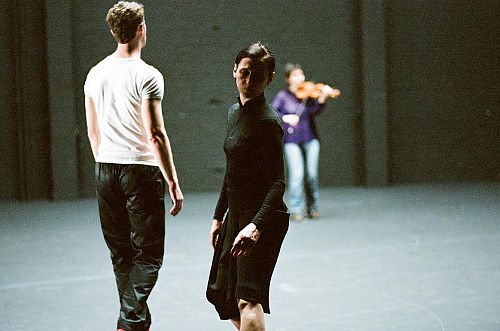 United Kingdom J.S. Bach, Partita 2: Anne Teresa De Keersmaeker, Boris Charmatz, Amandine Beyer, Rosas, Sadler’s Wells, London, 22.5.2015 (J.O’D)
United Kingdom J.S. Bach, Partita 2: Anne Teresa De Keersmaeker, Boris Charmatz, Amandine Beyer, Rosas, Sadler’s Wells, London, 22.5.2015 (J.O’D)

Dancers: Boris Charmatz, Anne Teresa De Keersmaeker
Violin: Amandine Beyer
Choreography: Anne Teresa De Keersmaeker
Created with Amandine Beyer, George Alexander van Dam
Scenography: Michel François
Costumes: Anne-Catherine Kunz
Sound: Alban Moraud
The stage and the flies at Sadler’s Wells had never looked so bare, so stripped down to essentials of black walls and roof. After the violinist Amandine Beyer had appeared through a door at the back, light itself was removed. In almost complete darkness, she began to play Johann Sebastian Bach’s Partita No. 2. Five, ten, fifteen minutes passed. The two women beside me had begun to look at each other with raised eyebrows and to hold up open palms of perplexity, when Beyer suddenly stopped playing and walked off the stage. Immediately afterwards, in light that had now returned, Anne Teresa De Keersmaeker and Boris Charmatz walked on.
The Belgian choreographer and the French ‘conceptual dance-maker’ met at the Festival at Avignon in 2010. Partita 2 is the result of that meeting. It is also the first time that De Keersmaeker, whose career began in 1982, has created a duet in which she herself appears. We can be grateful to Boris Charmatz for his part in making that happen. For when Amandine Beyer comes back, De Keersmaeker does not so much dance to the music of Bach, or even dance the music of Bach. What she does is to show the music of Bach flowing through her neat body so that she and it are one.
Despite his training at the Ecole de Danse de l’Opéra de Paris and at the Conservatoire National Supérior de Musique et de Danse de Lyon, Boris Charmatz does not have the same musicality. Perhaps, for someone whose work has been described as ‘a critique of representation’, that is the point. His longer-limbed, even ungainly body serves most of the time to point up the difference between his relation to the music and De Keersmaeker’s. As if aware of this, Charmatz ‘sits out’ a part of the performance, leaving De Keersmaeker and Beyer to a complicit duet by dancer and musician which a woman in the row in front of me sat forward to watch as some men do the ‘white’ acts of Swan Lake and La Bayadère.
‘I like the idea of dance minus one,’ Boris Charmatz said in an interview published in the programme to enfant, the work that he and his company, Musée de la danse, brought to Sadler’s Wells last January. The ‘minus one’ in Partita 2 is sometimes the music itself. Movement, at first, is performed in silence, or to the sound of the dancers’ humming. Once, at least, there is an exchange of words as Charmatz can be heard to say: ‘Let’s just do it.’
The dancers move, for the most part, along their own circular or elliptical paths. These are outlined in white, on the floor, as they were for the dancers of De Keersmaeker’s Vortex Temporum on the same stage last year. At one point, however, they link hands and match their footsteps in a silent, circular walk made complicated by the fact that one of them is standing up, the other lying down. By pulling and balancing with hands still linked, the dancers then reverse these positions. When repeated later on, and to music, this sequence becomes the crowning moment of the piece. Its effect is sublime.
John O’Dwyer
